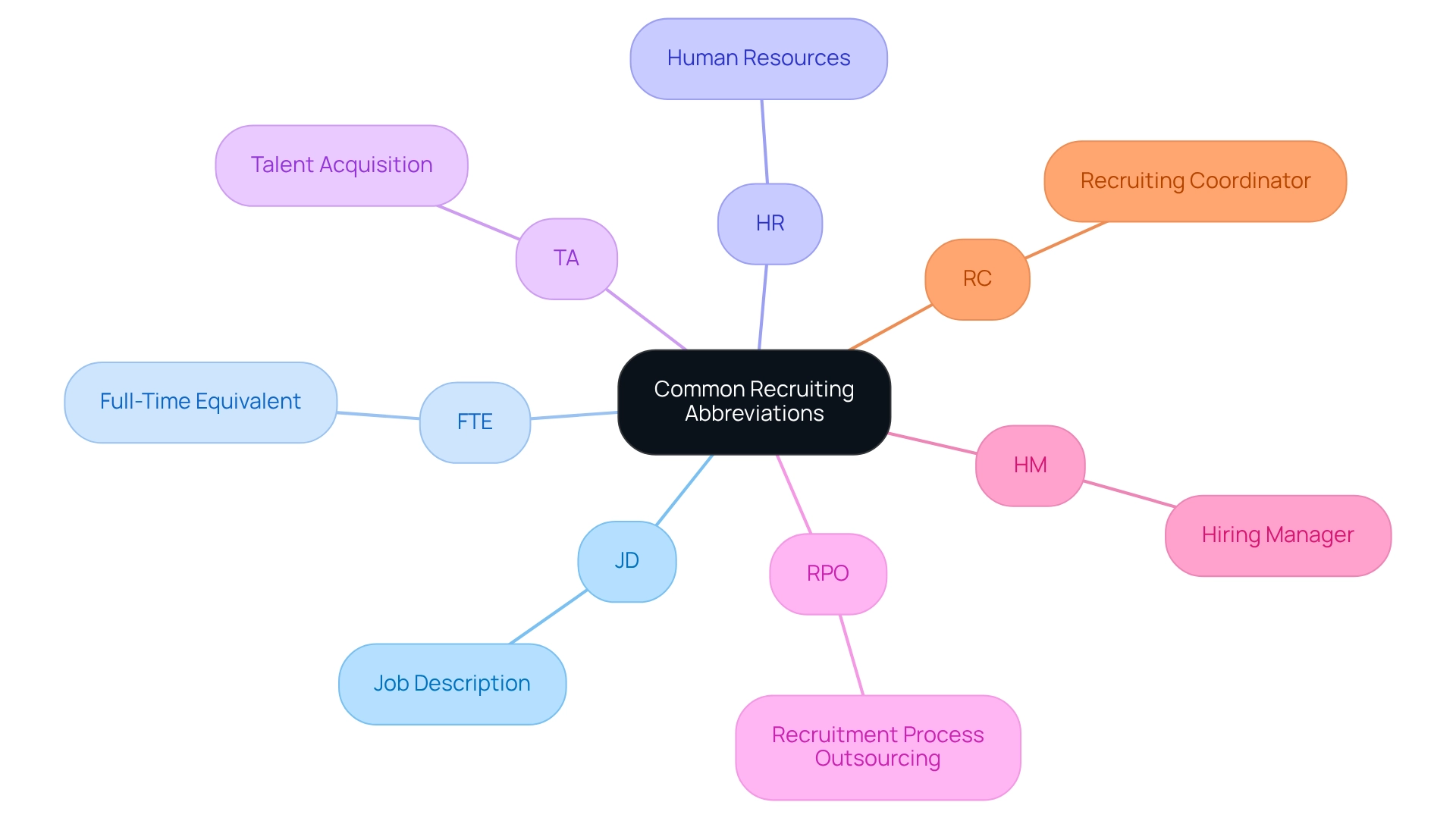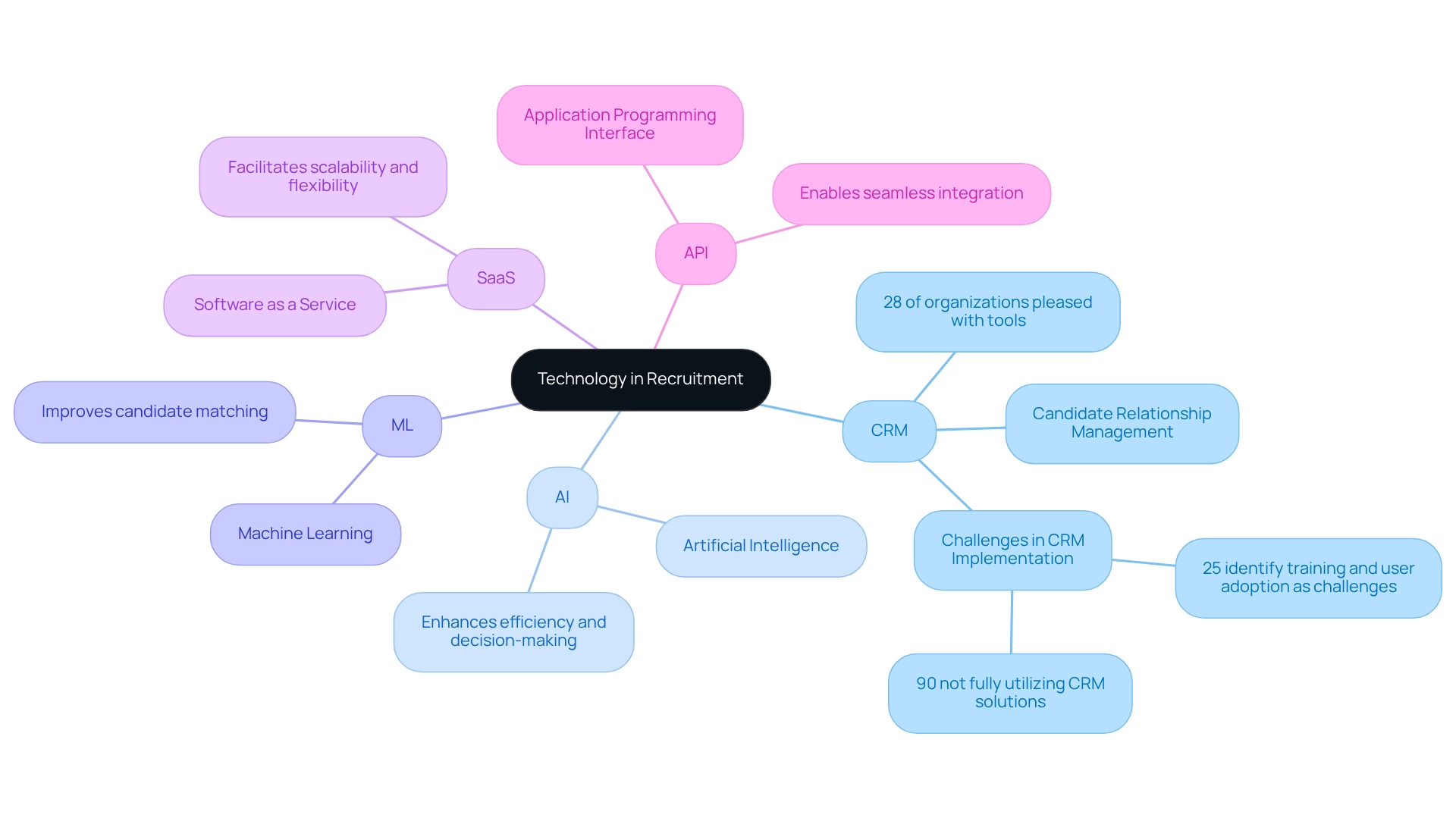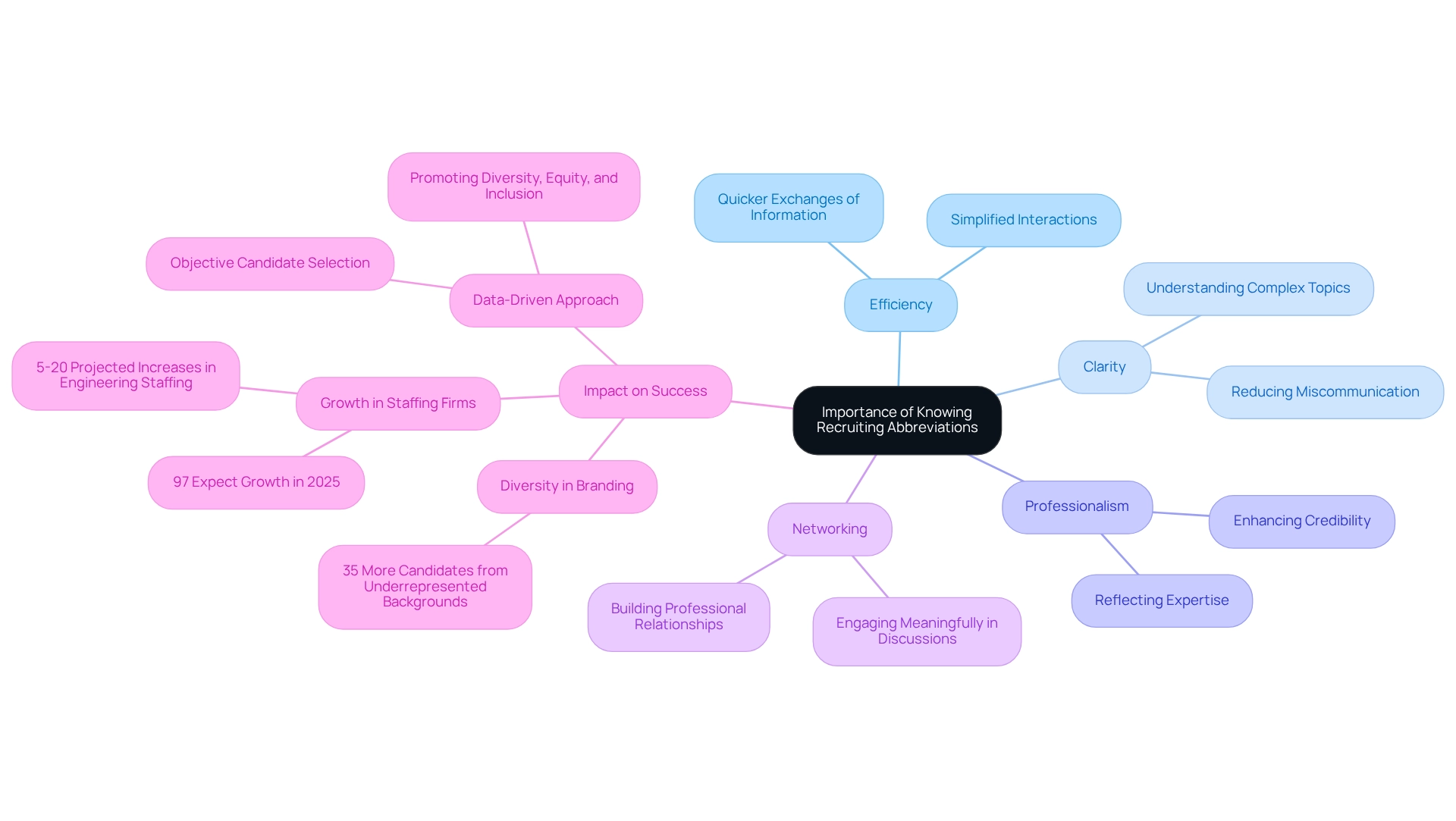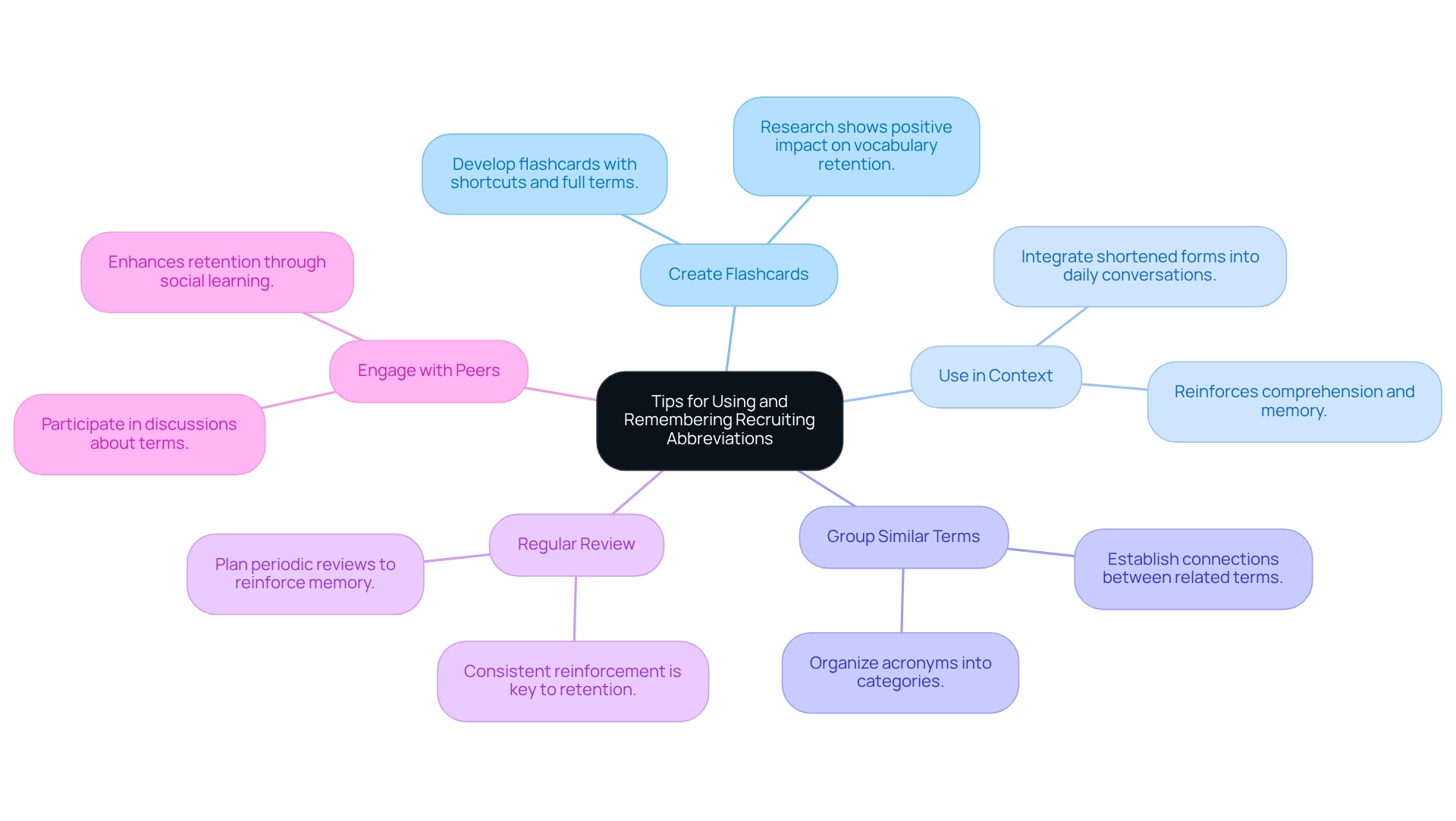Overview
Recruiting abbreviations play a crucial role in enhancing communication and efficiency throughout the hiring process. Terms such as ‘JD’ (Job Description) and ‘ATS’ (Applicant Tracking System) are vital for effective HR discussions. These abbreviations not only streamline interactions but also significantly reduce misunderstandings, thereby improving the overall applicant experience. Ultimately, this leads to more effective hiring outcomes. Consider how the implementation of these terms can transform your recruitment strategy.
Key Highlights:
- Recruiting abbreviations improve communication and efficiency in the hiring sector.
- Common terms include ‘JD’ (Job Description) and ‘ATS’ (Applicant Tracking System), crucial for HR discussions.
- 52% of talent acquisition teams use centralized texting platforms for better candidate interactions.
- 73% of companies believe clear job descriptions are essential for attracting potential hires.
- Abbreviations facilitate quicker exchanges and reduce misunderstandings in recruitment.
- Key acronyms such as ‘FTE’ (Full-Time Equivalent) and ‘RPO’ (Recruitment Process Outsourcing) streamline hiring processes.
- Technology-related abbreviations like ‘CRM’ (Candidate Relationship Management) and ‘AI’ (Artificial Intelligence) enhance recruitment efficiency.
- Understanding recruiting abbreviations fosters professionalism and better networking opportunities.
- Strategies for remembering abbreviations include using flashcards and engaging in peer discussions.
- Effective use of abbreviations leads to a more positive applicant experience and higher satisfaction rates.
Introduction
In the dynamic world of recruitment, effective communication is paramount. Understanding the language of the industry can make all the difference. Recruiting abbreviations serve as vital shorthand that not only streamlines conversations among HR professionals but also enhances the overall efficiency of the hiring process. From commonly recognized terms like JD (Job Description) to more specialized jargon, these abbreviations shape the way recruiters, hiring managers, and candidates interact.
As the recruitment landscape evolves, grasping these terms becomes essential for navigating the complexities of modern hiring. This understanding ensures that all parties are aligned and informed. Have you considered how these abbreviations impact your recruitment strategy?
This article delves into the significance of recruiting abbreviations, their impact on communication, and the strategies for mastering this crucial aspect of the recruitment process. By embracing this knowledge, you position yourself as an informed participant in the hiring dialogue, ultimately leading to more effective recruitment outcomes.
Understanding Recruiting Abbreviations: An Overview
Hiring acronyms serve as crucial shorthand within the hiring sector, significantly enhancing interaction and improving efficiency. These abbreviated forms encompass a variety of terms, ranging from commonly used expressions to specific jargon encountered by job seekers, hiring managers, and recruiters alike. Grasping the abbreviation for recruiting is essential for effective communication in the fast-paced hiring landscape, where clarity and speed are paramount.
For instance, terms such as ‘JD’ (Job Description) and ‘ATS’ (Applicant Tracking System) are not only widely recognized but also integral to daily discussions among HR professionals. The importance of clear messaging is underscored by recent statistics indicating that 52% of talent acquisition teams utilize centralized texting platforms to enhance candidate interactions. This trend reflects a growing emphasis on effective communication strategies within recruitment.
Furthermore, a notable 73% of companies assert that well-defined job descriptions and clear expectations are pivotal in attracting potential hires. This aligns with the notion that comprehending and employing the abbreviation for recruiting can significantly bolster the clarity of job postings and internal communications, ultimately leading to more effective hiring processes.
Recent trends in 2025 reveal a shift towards adopting more streamlined terms, mirroring the industry’s demand for speed and efficiency. Expert insights suggest that the abbreviation for recruiting not only facilitates quicker exchanges but also enhances hiring efficiency by reducing misunderstandings and ensuring alignment on key terms and processes. As Emily Neal, SEO and Content Specialist at DSMN8, articulates, “The importance of a strong employer brand extends far beyond recruitment: it plays a crucial role in retaining top talent, engaging employees, and even impacts shareholder returns.”
Case studies demonstrate that organizations prioritizing clear communication and attractive benefits are more successful in drawing applicants. For example, companies that effectively leverage short forms in their recruitment processes report increased efficiency and higher levels of applicant satisfaction. This is corroborated by a case study on candidate attraction techniques, which emphasizes that companies focusing on transparency and utilizing familiar terms create a more engaging hiring experience.
In doing so, they illustrate the tangible benefits of this practice in HR interactions, ultimately leading to improved hiring outcomes.
Common Recruiting Abbreviations You Should Know
In the hiring environment, several acronyms, such as the abbreviation for recruiting, play an essential role in simplifying interactions and boosting efficiency, especially for HR managers in financial companies. Consider the following commonly used terms:
- JD: Job Description
- FTE: Full-Time Equivalent
- HR: Human Resources
- TA: Talent Acquisition
- RPO: Recruitment Process Outsourcing
- HM: Hiring Manager
- RC: Recruiting Coordinator
These abbreviations are not merely shorthand; they are essential tools that facilitate clear and concise communication among HR professionals. For instance, when discussing a new position, a recruiter may refer to the ‘JD’ to succinctly outline the responsibilities and qualifications required for the role. This clarity is vital in ensuring that all stakeholders, including hiring managers and candidates, are aligned on expectations.
The application of these shortened forms also reflects a broader trend in the industry, where efficiency and precision are paramount. In 2025, the prevalence of these terms has been reinforced by their integration into everyday HR discussions, with many professionals reporting that utilizing short forms significantly speeds up the hiring process. According to industry experts, the use of ‘FTE’ allows HR teams to quickly convey staffing needs, which is crucial for effective workforce planning in the fast-paced financial sector.
Real-world examples demonstrate the effectiveness of these short forms in action. For example, a case study on a financial company that implemented ‘RPO’ showed a 30% decrease in time-to-hire, highlighting how outsourcing hiring tasks to specialized firms can improve the overall hiring process. HR professionals frequently leverage ‘TA’ to emphasize the strategic importance of sourcing top talent, which is particularly relevant in the competitive landscape of financial services.
Moreover, understanding these abbreviations for recruiting is crucial for navigating the complexities of recruitment. They not only enhance interaction but also promote a common language among HR teams, which is vital for cooperation and efficiency. As Inspector Letitia Pinas, Acting Head of the Trafficking in Persons Unit, noted, “Through improved collaboration, we can actively participate in inspections and ensure that our processes are streamlined and effective.”
This sentiment resonates within HR departments, where clear communication is key to successful hiring. As the hiring landscape continues to evolve, staying informed about these common abbreviations will empower HR professionals in financial firms to enhance their hiring strategies and achieve better outcomes. Are you ready to leverage these tools for your recruitment success?
Key Acronyms in Recruitment Processes
Key acronyms in hiring processes are critical to understanding the recruitment landscape, particularly in high-demand sectors such as finance and technology. These include:
- ATS: Applicant Tracking System
- KPI: Key Performance Indicator
- SOP: Standard Operating Procedure
- NDA: Non-Disclosure Agreement
- C2H: Contract to Hire
These acronyms represent essential components of the hiring workflow, each playing a pivotal role in enhancing efficiency and effectiveness. For instance, an ATS is a software application that enables the electronic management of hiring needs, significantly streamlining the process of tracking applicants and managing job postings. The ATS market has experienced significant growth in 2023, showcasing its essential role in contemporary hiring strategies.
KPIs are metrics utilized to assess the effectiveness of hiring efforts, aiding organizations in pinpointing areas for enhancement. Notably, 74% of organizations indicated that their hiring strategies were underperforming in 2022, underscoring the necessity for efficient KPI implementation to improve hiring results. Additionally, three-quarters of eligible applicants are turned away by ATS due to keyword discrepancies or not fulfilling certain requirements, emphasizing the difficulties individuals encounter in the hiring process.
SOPs provide standardized procedures that ensure consistency and compliance throughout the selection process. By establishing clear guidelines, organizations can enhance their recruitment efficiency and applicant experience. This is especially significant considering that only 26% of job seekers in the U.S. report having an excellent experience, as noted by JobScore, highlighting the necessity for structured processes that address the unique demands of finance and technology positions.
NDAs safeguard sensitive information during the hiring process, ensuring that both applicants and employers uphold confidentiality regarding proprietary data. This is vital in sectors where information security is essential.
C2H, or Contract to Hire, offers a flexible hiring solution that enables employers to assess an applicant’s suitability within the organization before extending a permanent offer. This method is increasingly favored as it reduces the risks associated with permanent placements, making it an appealing choice for financial companies aiming to attract top talent.
Understanding these acronyms, often referred to as the abbreviation for recruiting, is essential for anyone engaged in hiring, as they determine the processes and expectations within the employment procedure. A typical online job advertisement draws more than 250 applicants, yet only four to six are selected for a formal interview, illustrating the competitive nature of job markets and the significance of utilizing ATS and KPIs efficiently to filter through applicants. By leveraging these tools and concepts, Boutique Recruiting can strengthen its hiring strategies and ultimately boost success rates, ensuring that top talent is attracted and retained.
Technology-Related Abbreviations in Recruiting
In the evolving landscape of recruitment technology, several key abbreviations have emerged that are essential for understanding modern hiring practices:
- CRM: Candidate Relationship Management, a system that enables recruiters to cultivate and manage relationships with candidates, ensuring a tailored and engaging hiring experience. Significantly, only 28% of organizations are pleased with their tools to establish a shared, centralized view of customers, emphasizing the difficulties recruiters encounter in managing relationships effectively.
- AI: Artificial Intelligence, which streamlines various hiring processes, from sourcing individuals to interview scheduling, enhancing efficiency and decision-making.
- ML: Machine Learning, a subset of AI that analyzes data patterns to improve candidate matching and predict hiring outcomes, thereby increasing the quality of hires.
- SaaS: Software as a Service, a cloud-based model that enables staffing agencies to access software applications via the internet, facilitating scalability and flexibility in hiring operations.
- API: Application Programming Interface, which enables different software systems to communicate, allowing for seamless integration of various hiring tools and platforms.
These technology-related terms often serve as an abbreviation for recruiting, representing the tools and methodologies that are increasingly employed in hiring. For instance, CRM systems not only assist recruiters in managing relationships with applicants but also improve the overall experience for them by offering personalized interactions. As organizations face challenges in finding the right talent, leveraging these technologies becomes crucial.
A case study on CRM implementation emphasizes that 25% of businesses recognize training and user adoption as key challenges, which can significantly affect the efficiency of hiring technologies.
Moreover, the adoption of AI and ML in hiring is on the rise, with statistics indicating that 62% of talent teams sourcing through an Applicant Tracking System (ATS) find more high-quality candidates compared to those relying solely on inbound applications. This trend highlights the significance of incorporating advanced technologies into hiring strategies to enhance outcomes and efficiency. Additionally, 70% of companies use CRM to access customer data on mobile devices for improved decision-making, reinforcing the relevance of CRM systems in modern hiring practices.
As the hiring landscape continues to change, comprehending these terms and their implications will be essential for those involved in the abbreviation for recruiting, striving to remain competitive and efficient in their selection processes.
The Importance of Knowing Recruiting Abbreviations
For HR managers, understanding the abbreviation for recruiting is essential for several compelling reasons.
- Efficiency: Abbreviations simplify interactions, enabling quicker exchanges of information crucial in fast-paced recruitment environments.
- Clarity: They provide clarity in discussions, particularly when dealing with complex topics where lengthy terms may hinder understanding.
- Professionalism: Mastery of industry jargon reflects professionalism and expertise, enhancing credibility in interactions with both clients and applicants. This is especially significant since organizations that display diversity in their branding draw 35% more candidates from underrepresented backgrounds, highlighting the necessity for efficient interaction in recruitment.
- Networking: Familiarity with these terms fosters better networking opportunities, allowing professionals to engage more meaningfully in industry discussions.
For instance, a recent case study revealed that 97% of staffing firms anticipate growth in 2025, with many projecting increases between 5-20%, particularly in engineering staffing. This growth emphasizes the significance of transparent dialogue in a competitive market. Furthermore, as Eric Eddy pointed out, the firm’s capability to provide high-quality applicants swiftly and effectively is closely linked to efficient interaction, which is supported by understanding the abbreviation for recruiting.
Moreover, a data-driven approach encourages diversity, equity, and inclusion by assisting in the selection of the most suitable candidates impartially, further highlighting the significance of being knowledgeable in industry terminology.
In summary, being knowledgeable in the abbreviation for recruiting and other recruiting terms greatly improves interaction efficiency throughout the hiring process, ultimately aiding in successful placements and stronger professional relationships.
Tips for Using and Remembering Recruiting Abbreviations
To effectively utilize and retain recruiting shortcuts, consider the following strategies:
- Create Flashcards: Develop flashcards with the shortcut on one side and the full term on the other. Research indicates that the use of flashcards positively impacts vocabulary retention, as seen in a study where this method helped intermediate learners effectively develop their vocabulary during online instruction. This method enables self-assessment and strengthens memory retention.
- Use in Context: Regularly integrate shortened forms into your daily conversations and professional communications. This contextual usage aids in reinforcing your comprehension and memory.
- Group Similar Terms: Organize acronyms into categories, such as technology or processes. This grouping method assists memory by establishing connections between related terms.
- Regular Review: Plan periodic reviews of the shorthand to keep them fresh in your mind. Consistent reinforcement is key to long-term retention.
- Engage with Peers: Participate in discussions with colleagues about these terms. Engaging in peer conversations enhances retention through social learning, as sharing knowledge can deepen understanding. As Ismail Xodabande observes, there is a necessity for varied vocabulary acquisition resources, which can encompass techniques such as flashcards.
By applying these approaches, professionals can greatly enhance their understanding of the abbreviation for recruiting terms, ultimately boosting their effectiveness in the HR domain. Notably, in educational contexts, effective learning strategies, such as those mentioned, accounted for 30% of students’ overall course evaluations, suggesting that similar methods could be beneficial in HR training contexts.
The Impact of Abbreviations on the Recruiting Process
Shortened forms play a crucial role in enhancing the recruiting process through various dimensions:
- Streamlined Communication: Utilizing shortened forms allows recruiters to convey essential information swiftly, eliminating the need for lengthy explanations. This efficiency is vital in a fast-paced hiring environment where prompt interaction can significantly impact outcomes. Boutique Recruiting emphasizes the importance of clear and thorough job descriptions, particularly when using abbreviations for recruiting, to ensure effective communication.
- Enhanced Collaboration: Shortened forms foster effective communication among recruitment teams, especially when collaborating across departments or with external partners. This improved dialogue is essential for aligning goals and strategies, ultimately leading to better hiring outcomes. Boutique Recruiting’s custom searches are designed to address the distinctive requirements of businesses, sectors, and regions, enhancing cooperation among diverse teams.
- Enhanced Applicant Experience: When recruiters utilize familiar abbreviations, it fosters a more professional and structured interaction for applicants. This clarity not only improves the applicant experience but also builds trust, as candidates feel more informed and engaged throughout the hiring process. Boutique Recruiting’s tailored approach ensures that applicants receive the attention and clarity they deserve.
- Increased Efficiency: Reducing time spent on explanations allows recruiters to focus on strategic initiatives, such as applicant engagement and relationship building. This shift is crucial in a competitive job market where establishing connections can lead to successful placements. Boutique Recruiting’s emphasis on tailored recruitment solutions enables recruiters to enhance their efficiency and effectiveness.
The influence of shortened forms extends beyond mere convenience; they significantly boost recruitment efficiency. Organizations that prioritize clear exchanges, including the use of abbreviations, have reported a 54% response rate from employed individuals in surveys, indicating a strong relationship between effective interaction and applicant satisfaction. Furthermore, engaged workplaces experience 41% reduced absenteeism, demonstrating how efficient communication enhances morale and productivity.
Integrating feedback from applicants is also crucial. Organizations that actively seek applicant feedback are 65% more likely to receive referrals, underscoring the significance of a positive applicant experience. This is supported by a case study on candidate feedback and goodwill, which highlights that gathering candidate feedback is essential for enhancing the hiring process and fostering goodwill.
By nurturing long-term relationships through clear and concise dialogue, organizations position themselves as preferred employers, ultimately attracting top-tier talent. Thus, the strategic use of abbreviations in recruiting not only simplifies communication but also enhances the overall effectiveness of the hiring process.
At Boutique Recruiting, we specialize in custom searches for roles such as Chief Technology Officer, Engineer, HR Director, and more across the U.S. and Canada. Contact us today to learn how we can assist you in your recruitment needs.
Conclusion
Understanding and utilizing recruiting abbreviations is essential for navigating the complexities of modern hiring processes. These terms not only streamline communication among HR professionals but also enhance overall efficiency, ensuring that all parties involved are aligned and informed. Key abbreviations such as JD, ATS, and FTE serve as vital shorthand that facilitates clearer discussions and quicker decision-making, ultimately leading to better recruitment outcomes.
Moreover, the importance of these abbreviations extends beyond mere convenience. They contribute significantly to a professional image, foster improved collaboration, and enhance the candidate experience. As organizations increasingly prioritize effective communication strategies, mastering these terms becomes crucial for HR professionals aiming to attract and retain top talent in a competitive market.
In conclusion, embracing the language of recruitment through abbreviations is not just a matter of efficiency; it is a strategic advantage that can shape hiring success. By investing time in understanding and using these terms, recruiters and hiring managers can create a more engaging and effective recruitment process, ultimately positioning their organizations as leaders in talent acquisition.
Frequently Asked Questions
What is the significance of hiring acronyms in the recruitment sector?
Hiring acronyms serve as crucial shorthand within the hiring sector, enhancing interaction and improving efficiency among job seekers, hiring managers, and recruiters.
Can you provide examples of common hiring acronyms?
Common hiring acronyms include JD (Job Description), FTE (Full-Time Equivalent), HR (Human Resources), TA (Talent Acquisition), RPO (Recruitment Process Outsourcing), HM (Hiring Manager), and RC (Recruiting Coordinator).
How do hiring acronyms improve communication in recruitment?
Hiring acronyms facilitate clear and concise communication, allowing stakeholders to align on expectations and responsibilities quickly, which is essential in the fast-paced hiring landscape.
What recent trends are influencing the use of hiring acronyms?
Recent trends indicate a shift towards adopting more streamlined terms to meet the industry’s demand for speed and efficiency, with many professionals reporting that using short forms significantly speeds up the hiring process.
What impact do clear job descriptions have on recruitment?
Well-defined job descriptions and clear expectations are pivotal in attracting potential hires, with 73% of companies asserting their importance in the hiring process.
How do hiring acronyms contribute to hiring efficiency?
Understanding and using hiring acronyms reduces misunderstandings and ensures alignment on key terms and processes, ultimately enhancing hiring efficiency.
Can you provide an example of how hiring acronyms have improved hiring outcomes?
A case study showed that a financial company implementing Recruitment Process Outsourcing (RPO) experienced a 30% decrease in time-to-hire, demonstrating improved efficiency in the hiring process.
Why is it important for HR professionals to stay informed about hiring acronyms?
Staying informed about hiring acronyms empowers HR professionals to enhance their hiring strategies, promote cooperation, and achieve better outcomes in a competitive recruitment landscape.







